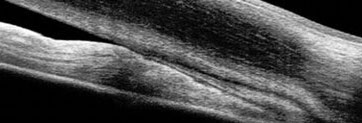 |
|
When more than half of the trabecular meshwork is obstructed by angle closure, glaucoma patients are at higher risk of IOP elevation and might require more frequent follow-up. Photo: Michael Cymbor, OD. Click image to enlarge. |
As the number one cause of vision loss worldwide, glaucoma is a prevalent condition that demands frequent monitoring and aggressive intervention. Understanding which patients bear the highest risk of ocular complications such as elevated intraocular pressure (IOP) is important to make informed treatment and follow-up recommendations. To help advise these decisions, it’s important to look at the extent of angle closure, as well as its circumference, as a new study suggests these factors have a direct effect on the risk of elevated IOP. After using a mechanistic model of aqueous humor flow to study the correlation, researchers concluded in their paper in Translational Vision Science & Technology that the mean and median IOP increased with increasing number of sectors with angle closure. They also observed that the IOP increase was most pronounced when five or more sectors were closed.
The researchers described the study method in their paper as follows: “Aqueous humor flow through conventional and unconventional outflow pathways was modeled using the unified Stokes and Darcy equations, which were solved using the finite element method. The severity and circumferential extent of angle closure were modeled by lowering the permeability of the outflow pathways.” The model’s IOP predictions were then compared with biometric and IOP data from the Chinese American Eye Study. Anterior segment OCT measurements of angle opening distance determined the circumferential extent of angle closure.
The researchers observed that when the extent of angle closure was small (less than half of the circumference), IOP rise was slow, but greater angle closure extent led to rapid IOP elevation. They reported in their paper that the model’s predictions showed “an initial linear rise in IOP with increasing extent of angle closure which became nonlinear when the extent of closure exceeded around one-half of the circumference.” Additionally, they wrote, “The nonlinear rise in IOP was associated with a nonlinear increase in aqueous humor outflow velocity in the open regions of the angle.” Predictions from both the clinical data and mechanistic model supported a nonlinear relationship between angle closure and IOP.
In conclusion, the researchers wrote in their paper that “IOP elevation occurs rapidly when more than half of the trabecular meshwork is obstructed by angle closure.” The extent and circumference of angle closure could help you determine if more aggressive monitoring or treatment may be necessary for glaucoma patients at higher risk of IOP elevation.
Murgoitio-Esandi J, Xu BY, Song BJ, et al. A mechanistic model of aqueous humor flow to study effects of angle closure on intraocular pressure. Transl Vis Sci Technol. 2023;12(1):16. |


